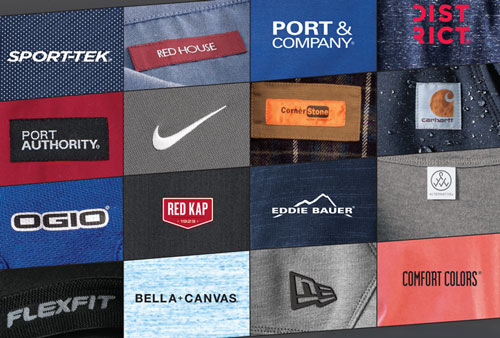Branded Clothing Maintenance Tips Based on Fabric Composition
Branded Clothing Maintenance Tips Based on Fabric Composition
Blog Article
Understanding Clothes: The Relevance of Material Options in Your Wardrobe
The option of material in clothing plays an essential role in both looks and performance. Various products provide differing levels of breathability, convenience, and longevity, straight affecting the user's experience. Comprehending these subtleties can boost one's closet substantially. Yet, many ignore how these options can affect not just individual style, yet likewise sustainability. What material decisions could redefine your closet and align it with both style and responsibility?
The Duty of Textile in vogue and Capability

Usual Fabric Kinds and Their Attributes
When selecting clothes, recognizing the qualities of typical fabric kinds is necessary for making notified choices. Cotton, a widely-used all-natural fiber, is understood for its versatility, breathability, and soft qualities, making it ideal for informal wear and daily garments. Linen, one more natural alternative, boasts outstanding moisture-wicking residential properties and an unique texture, suitable for cozy climates.Wool, typically preferred for its heat and longevity, differs in excellence; merino woollen is soft against the skin, while coarser kinds are made use of for outerwear. Artificial fabrics like polyester and nylon use longevity and resistance to creases, making them preferred for activewear and travel garments. Blends, which incorporate synthetic and natural fibers, can boost performance while keeping comfort. By identifying these material qualities, individuals can select clothing that aligns with their lifestyle and aesthetic preferences.
Breathability and Comfort: Picking the Right Fabrics for Different Environments
Picking the appropriate materials for various climates can significantly boost convenience and total wearability. Breathable materials are crucial in warm environments, as they permit air circulation and moisture dissipation. Fabrics such as cotton, bed linen, and moisture-wicking synthetics effectively draw sweat far from the body, keeping the user cool and dry. Alternatively, in chillier climates, thicker materials like wool or fleece offer insulation while keeping breathability, guaranteeing heat without overheating.Additionally, the choice of textile weight plays a vital function; lightweight fabrics are better for summer, whereas heavier alternatives are suited for winter months wear. Comprehending the one-of-a-kind properties of each fabric enables people to clothe appropriately for differing weather. Eventually, selecting comfy and breathable materials tailored to particular climates can significantly boost everyday convenience and enhance the total experience of wearing clothing.
Durability and Care: Just How Textile Affects Long Life of Your Closet
Selecting the right materials can greatly impact the toughness and care demands of a wardrobe. Fabrics such as cotton and polyester are recognized for their strength and convenience of maintenance, making them ideal for day-to-day wear. In contrast, fragile materials like silk and lace call for more mindful handling and specialized cleansing techniques, which can increase the moment and initiative required for care. Branded Clothing.Durability is additionally influenced by the fabric's weave and surface; snugly woven fabrics tend to withstand deterioration far better than freely woven options. Furthermore, synthetic blends typically offer improved toughness, incorporating the most effective qualities of numerous fibers.Understanding the treatment directions for each fabric is important, as inappropriate drying or washing can result in premature wear. Eventually, selecting sturdy products can result in a longer-lasting closet, decreasing the regularity of substitutes and contributing to a much more sustainable style selection
The Influence of Textile on Fit and Silhouette

Sustainable Material Options: Making Eco-Friendly Decisions
The impact of textile expands past fit and silhouette to encompass environmental variables, triggering a growing interest in sustainable fabric choices. Environment-friendly fabrics, such check out this site as natural cotton, hemp, and Tencel, are obtaining grip among consumers that prioritize sustainability in their wardrobes. These products are commonly produced with less chemicals and water, decreasing their ecological footprint.Additionally, recycled textiles, made from post-consumer waste, use an ingenious option to the textile sector's pollution issue. Brands increasingly accept transparency in their sourcing approaches, allowing consumers to make informed decisions about their purchases.Choosing lasting textiles not just sustains honest techniques however likewise urges the apparel industry to take on more responsible manufacturing techniques. As understanding of ecological issues climbs, people are prompted to review the lasting effect of their textile options, promoting a motion towards a much more ecologically aware and sustainable strategy to style.
Boosting Style: How Textile Can Change a Clothing
While many may focus on color and cut when picking an attire, the choice of fabric plays a necessary duty in elevating style and improving overall appearance. Various products communicate distinctive state of minds and messages; for instance, silk radiates luxury and refinement, while denim uses an informal, kicked back vibe. The appearance and drape of a textile can drastically alter the silhouette, with organized fabrics giving a refined look and softer ones producing an extra fluid, kicked back aesthetic.Moreover, the weight of the material influences wearability across seasons. Light-weight textiles like linen and cotton are optimal for summer, while much heavier products such as wool and velvet offer warmth and elegance in colder months. Understanding material residential or commercial properties, such as breathability and stretch, also empowers individuals to make educated options that boost convenience without jeopardizing design. Inevitably, the appropriate material can change an attire from regular to amazing, making it a crucial consideration in any type of wardrobe.
Frequently Asked Inquiries
How Do I Determine the Textile Material of My Apparel?
To recognize material content, one can analyze care labels, conduct melt examinations for fiber identification, or speak with material swatches. These techniques assist set apart products, guaranteeing notified options for clothing treatment and maintenance in day-to-day wear.
Can Material Choice Affect My Mood or Confidence?
Fabric selection can other significantly impact an individual's state of mind and confidence. Branded Clothing. Particular products might stimulate sensations of comfort or beauty, while others can really feel restrictive or unflattering, inevitably affecting self-perception and emotional health throughout the day
What Fabrics Are Ideal for Delicate Skin?
For individuals with delicate skin, all-natural textiles like cotton, linen, and bamboo are typically advised. These products are breathable, hypoallergenic, and much less likely to create irritation, making them ideal choices for comfort and skin wellness.
Exactly how Do I Effectively Wash and Look After Different Fabrics?
To correctly wash and care for different textiles, one must take into consideration each material's details demands, consisting of temperature settings, cleaning agents, and drying out methods, guaranteeing longevity and preserving the textile's initial high qualities for optimal use.
Exist Particular Fabrics for Athletic or Efficiency Put On?
Sports or efficiency wear commonly utilizes fabrics such as nylon, spandex, and polyester. These products are designed for moisture-wicking, breathability, and adaptability, boosting activity and convenience throughout exercises while giving sturdiness and support. Conversely, in colder climates, thicker fabrics like wool or fleece supply insulation while preserving breathability, making sure heat without overheating.Additionally, the option of fabric weight plays an essential function; light-weight textiles are more effective for see this site summer, whereas heavier choices are fit for winter season wear. In comparison, delicate materials like silk and shoelace call for more careful handling and specialized cleaning methods, which can boost the time and effort required for care.Durability is likewise influenced by the fabric's weave and surface; securely woven materials often tend to withstand wear and tear far better than loosely woven alternatives. In contrast, inflexible fabrics can limit motion but provide a traditional, polished look.Moreover, the density and appearance of the material can affect the aesthetic perception of body form. The influence of fabric prolongs beyond fit and silhouette to incorporate ecological aspects, prompting an expanding interest in lasting fabric options. The structure and drape of a fabric can dramatically alter the silhouette, with structured textiles providing a sleek appearance and softer ones producing a more fluid, relaxed aesthetic.Moreover, the weight of the material influences wearability across seasons.
Report this page